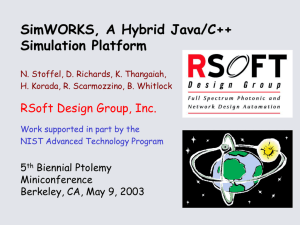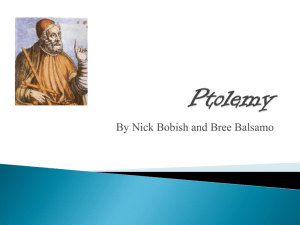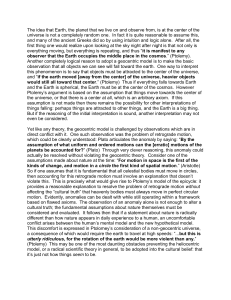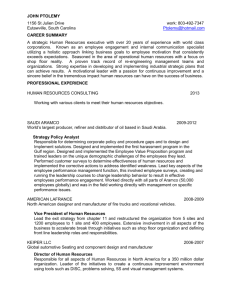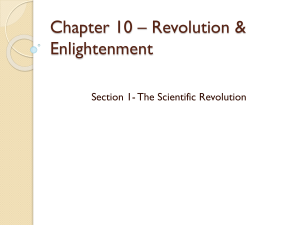MESCAL Application Modeling and Mapping: Warpath Andrew Mihal and the MESCAL team
advertisement
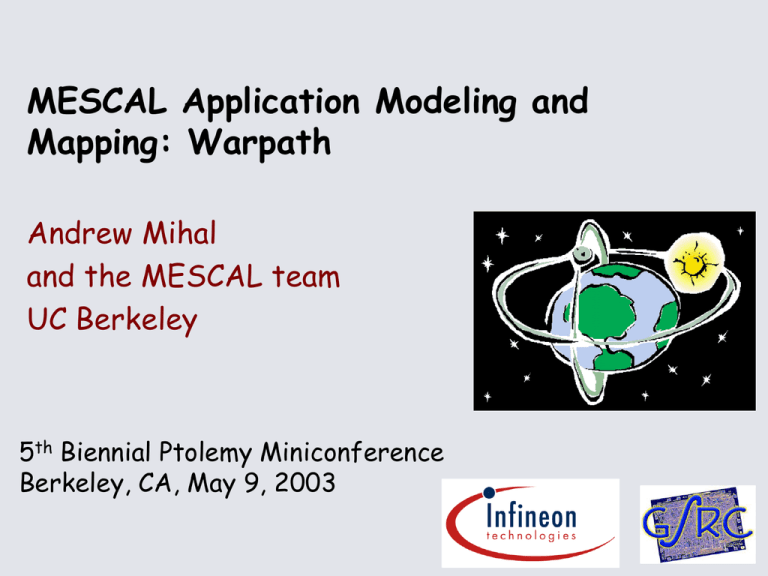
MESCAL Application Modeling and Mapping: Warpath Andrew Mihal and the MESCAL team UC Berkeley 5th Biennial Ptolemy Miniconference Berkeley, CA, May 9, 2003 Complex Systems • Heterogeneous Architectures – Diverse computational resources – Diverse communications architecture – Diverse memory architecture • Concurrent Applications – Multiple flavors of concurrency – Models of Computation Ptolemy Miniconference 2 Three Challenges • Choose the right application development environment – Capture application’s requirements – Useful high-level abstractions • Find a good programming model for the architecture – Capture architecture’s capabilities – Right mix of opacity and transparency • Transition between application development environment and programmer’s model (implement) – Enable efficient design space exploration – Correct results – Meet performance goals Ptolemy Miniconference 3 MESCAL Approaches • Bottom-up – Start with a specific application domain and a specific architecture – Develop useful abstractions of the device – Aspire to achieve hand-coded performance in a fraction of the design time • Top-down – Consider heterogeneous applications that use combinations of MoCs – Develop a mapping discipline • Correct-by-construction implementation • Target a broad class of architectures Ptolemy Miniconference 4 Warpath • Disciplined methodologies and a supporting tool set for the top-down approach Applications Applications Applications Architecture Instance Programmer’s Model Mapping Process Formal model enables automatic exportation Application Development Environment Formal models capture concurrency Code Generation Process Correct-by-construction implementation Performance Analysis Ptolemy Miniconference 5 Outline • Target Architectures – Exporting programming models • Target Applications – Characteristics of application development environments • Mapping Programmer’s Model Mapping Process Application Development Environment Ptolemy Miniconference 6 Target Architectures • Teepee Processing Element Architecture View – – – – – Successor to Architecture Description Languages Library of components MoC captures register-to-register data transformations Formal analysis finds “operations” Not limited to RISC-like datapaths • DLX-like machine: Ptolemy Miniconference 7 Operation Extraction Ptolemy Miniconference 8 Programming Models • Teepee architectures are fundamentally different from conventional RISC machines • RISC datapath features: – Instruction fetch/decode units – Program counter – Part of the computation in each cycle is to figure out the next instruction to run • Runs sequential programs with jumps • C language – – – – Arithmetic operations Loops Function calls 20% of the architectural details, 80% of the performance Ptolemy Miniconference 9 Teepee Processing Elements • Control structures are implicit in the model • Control synthesis strategies: – – – – – Hardcoded state machine Horizontal/vertical microcode Reconfigurable RISC/VLIW None of the above • Runs sequential programs Executes one or more operations each cycle • Opportunity to customize processing element control to the style of computation the application uses Ptolemy Miniconference 10 Target Applications • Heterogeneous, concurrent applications • Click network processing apps • Data plane: Ptolemy Miniconference 11 Click Applications • Control plane: Routing table updates Dynamic Quality-ofService changes ICMP Errors (bad packets) Flow-based router context Statistics gathering Ptolemy Miniconference 12 Warpath Application Development Env. • Good ideas from Ptolemy II – Models of Computation – Orthogonalization of computation, communication, and control – Library of domain-polymorphic components – Hierarchical heterogeneity • Targeted for implementation on a Teepee architectural platform – Strict software interfaces for computation, communication, control – Separate implementation and visualization – Get rid of Java – Don’t assume RISC-like datapaths Ptolemy Miniconference 13 Application Mapping • Common abstractions on each end of the implementation transition C Operations RISC Datapath Teepee Processing Element • Warpath application development environment describes application computation in terms of operations Ptolemy Miniconference 14 Add Actor • Model an abstract machine that has an operation that performs the add mathematical function Look Inside • Thinking of this as a software model instead of a hardware model • Operational semantics Ptolemy Miniconference 15 Compositions of Actors ? • Obtain a graph of abstract machines • Lacks semantics of control and communication • Adding a model of computation makes this concrete Ptolemy Miniconference 16 Compositions of Actors • Receiver: operations to read and write a token to a storage element • Director: operations to invoke operations on other abstract machines Ptolemy Miniconference 17 Implementation • Base case: think of the application model as a hardware model • One-to-one relationship between application components and architecture components Acts like an instruction fetch unit Hardware function unit “Datapath” Ptolemy Miniconference 18 Implementation • Next: Programmable platform – Compile programs for one or more PEs so that they execute the operations specified by the application model Ptolemy Miniconference 19 Summary • We maintain that the key is to have common abstractions on each end of the implementation transition • Actors and domain components described in terms of operations – Operational semantics for an abstract architecture – Retargetable compilation process • Designers can tune architectures to match the application – Application MoC influences PE control logic – Program counters, stacks in memory, etc. optional – Add special function units that perfom domain-specific operation – Explore customization/programmability tradeoffs Ptolemy Miniconference 20 The MESCAL Team • • • • Kurt Keutzer Matthias Gries Christian Sauer Kees Vissers • • • • • • • Yujia Jin Andrew Mihal Matt Moskewicz Will Plishker Kaushik Ravindran Niraj Shah Scott Weber Ptolemy Miniconference 21
